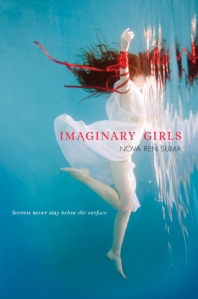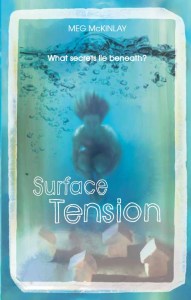Yesterday I wrote about creative ‘coincidences’, perhaps more aptly described as a certain kind of alignment. Anna Branford, author of the gorgeous Violet Mackerel books had an interesting take on this in the comments, in response to which I will simply nod my head and refer you there.
If you want to see a really interesting example of how this sort of thing might work, check out this Derren Brown experiment in subliminal communication. It’s fascinating stuff.
But to the point I was writing towards yesterday – Surface Tension and the oh no! moment. Here’s what happened.
There’s an online community I frequent from time to time, where writers gather and talk about all sorts of things. Late last year, Nova Ren Suma posted the cover of her forthcoming novel, Imaginary Girls. It was beautiful. We oohed and aahed. Then I noticed the strapline:
 Secrets never stay below the surface.
Secrets never stay below the surface.
Nice, right? Eerie, atmospheric, makes you want to read on.
It was also one of the lines we had been tossing up for Surface Tension.
That didn’t matter, of course. It was just a strapline. And in any case, we had decided to go with something different:
What secrets lie beneath?
But it did make me curious. What was this book that could be straplined so similarly to mine? What was it about? I had that crawling feeling under my skin that I was about to encounter another ‘But that’s my book!’ moment. I clicked over to Nova’s site, and was reassured. Her book was about someone who drowned, about sisters. It sounded nothing like mine.
I forgot about it.
Then a few weeks ago, Nova posted again, this time to let us know that her publisher had made the first few chapters of Imaginary Girls available online. I clicked over to read it, not because I was concerned, but because I’d read an excerpt of Nova’s earlier novel, Dani Noir, and remembered loving the writing.
I started reading. I loved the writing. I thought wow, this is great.
And then I thought wait, what?
There was a reservoir. I had missed that when I read the synopsis earlier. It probably didn’t seem important in and of itself. But now it did. Now I was reading the line Most people weren’t aware of our reservoir’s history; they didn’t think about what had been here before. I was discovering that Nova’s book was set in and around a drowned town, just like mine was, that her female protagonist was swimming the reservoir, wondering about the lives sunk below her, just like mine did. That this was a book that engaged with history and the construction of story, but that the protagonist’s stories were written by her sister rather than herself.
I was freaking out, just a little.
I read Nova’s blog. I discovered that Imaginary Girls was going to be published in Australia.
I may have freaked out a little more.
Then I went back and read her chapters – all of them this time, more slowly and with less freaking out.
It’s a different book. It’s for an older YA audience, whereas mine is junior fiction, pushing into lower YA. And after that first chapter, it’s clear that the narrative heads in a very different direction to mine.
I sent Nova a message, just to give her a heads-up, so she wouldn’t run across my book one day, just before her Australian publication date and have her own temporary freak out. She replied with surprise, and admirable calm. She reassured me further. Her book is magical realism. Mine is a realist mystery. The atmospheric setting of the drowned town, with all its metaphoric possibilities, is the same, but it’s not the heart of the book.
They’re very different books, though they come from a similar place. The setting for Nova’s book comes from the area she lived in as a teenager. The setting for mine comes from a place I visited as a teenager. It’s hardly surprising that the image of what is a singular sort of location lodged in our imaginations, to erupt years later as part of our creative lives.
location lodged in our imaginations, to erupt years later as part of our creative lives.
I’m so glad I got on and wrote the book when I did. The image of the drowned town is something I’ve wanted to work with for years – I just didn’t know how. Had I not already written the book, seeing Nova’s, as different as it ultimately is, may have given me pause. After all, that’s my setting, my idea. And based on what little I’ve seen of Imaginary Girls, the way Nova writes about the submerged town has enough in common with my own preoccupations that, having seen her book, I suspect I would have felt odd about continuing down the path I had planned.
One final odd coincidence: Nova posted on 8 April that her book will be published here in Australia. I learned on 9 April that mine will be published in the US. A book exchange across the ocean.
So all is well, in the end. Better than well. Imaginary Girls is out here in Australia with Pier 9 on July 1. And it’s stunning. I can’t wait to pick up a copy from the “Drowned Towns” section of my local bookstore.

File under Spooky Quantum Stuff or Littlewood's Law. I recently had three pigeon synchronicities in one day
LikeLike
Pigeon synchronicities! That phrase has made my day.
LikeLike
This was great to reaad
LikeLike